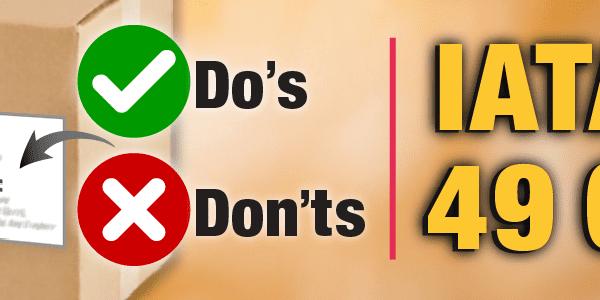On June 1, 2016, Transport Canada issued an amendment to the “Transportation of Dangerous Goods Regulations” (TDG) under the Transportation of Dangerous Goods Act. This amendment substantially revises the requirements for reporting spills of dangerous goods during transportation. It also addresses changes to air shipment of lithium ion batteries and makes various minor corrections and changes. The “Reporting Requirements and International Restrictions on Lithium Batteries Amendment” reflects concerns that the previous requirements for reporting spills, called “accidental releases,” was inefficient and didn’t allow the reporting parties to evaluate the risk to the public when deciding if a release had to be reported.
Changes to Reporting – Surface Transport
The section on reporting accidental releases, Part 8, called “Accidental Release and Imminent Accidental Release Report Requirements,” has been removed from the regulations and replaced with a new Part 8 titled simply “Reporting Requirements”.
First, the amendment removes the definitions for “accidental releases” and “anticipated accidental releases” and replaced them with definitions for “releases” and “anticipated releases”. This means that the reporting requirements will now cover intended releases as well as those that occur by accident.
Next, Transport Canada has adjusted the quantities of a release that would trigger reporting. For road, rail and water transport, these changes include:
- The limit is lowered to any amount for Class 1, Explosives; Class 2, Compressed Gases; Classes 3, 4, 5, 6.1, or 8, in Packing Group I or II; and Division 6.2, Infectious Substances.
- The limit is set at 30 Litres of a liquid, or 30 kilograms of a solid, for Classes 3, 4, 5, 6.1 or 8, in Packing Group III, or Class 9, Packing Group II or III.
- For radioactives in Class 7, reporting is required for a release of ionizing radiation greater than the level established in section 39 of the “Packaging and Transport of Nuclear Substances Regulations, 2015.”
For any of these releases, the person in charge of the goods must “make an emergency report to any local authority that is responsible for responding to emergencies at the geographic location of the release or anticipated release.” This would be similar to the previous system, where spills were to be reported to the local police in most provinces.
Then, Transport Canada adds an additional tier of immediate reporting. The release must be reported to:
- the agency CANUTEC, at 1-888-CANUTEC (1-888-226-8832) or 613-996-6666;
- the consignor of the dangerous goods;
- in the case of dangerous goods included in Class 7, Radioactive Materials, the Canadian Nuclear Safety Commission; and
- in the case of a ship, a Vessel Traffic Services Centre or a Canadian Coast Guard radio station.
However, this second tier reporting requirement is only required when certain circumstances are met. These are:
- someone has been killed;
- someone has required immediate medical treatment;
- an evacuation or “shelter in place” order has been given; or
- there has been a closure of a facility used in the loading and unloading of dangerous goods, or a road, a main railway line or a main waterway.
This provision means that for spills with no serious consequences, reporting to local authorities will be sufficient – no report to CANUTEC or written report is required.
The list of requirements for immediate reporting has been updated to include the name and contact information of the person making the report. This is obviously important information in managing spill response, but had not been included in prior versions of the reporting requirements.
If the release triggered the second tier of reporting to CANUTEC and related authorities, only then will a written report to Transport Canada be required. The list of required information has been updated and now includes the names and contact information of the consignor, consignee and carrier, as well as more detailed information about the conditions of the release.
While not specifically addressed in the text of the amendment, Transport Canada is introducing a voluntary reporting form which will eventually be available on their web site. While the form will help standardize reports, it is not intended to be mandatory, just to provide a template which will reduce Transport Canada’s workload in processing reports that may come in many formats.
Changes to Reporting – Air Transport
Releases that are related to air transportation (including offering for transport and handling at aerodromes and air cargo facilities) have a separate reporting section. The triggering amounts are:
- for classes 1, 2, 3, 4, 5, 6, 8 or 9, any amount; and
- for class 7, a level of ionizing radiation greater than the level established in section 39 of the “Packaging and Transport of Nuclear Substances Regulations, 2015”.
The report must be made to CANUTEC and, in the case of dangerous goods included in Class 7, Radioactive Materials, to the Canadian Nuclear Safety Commission. However, the report is not required if the release or anticipated release does not result in any of the following:
- the death or injury of a person;
- damage to property or to the environment;
- signs that the integrity of a means of containment has been compromised, including signs of fire, of breakage or of fluid or radiation leakage;
- serious jeopardy to persons on an aircraft or to the aircraft itself;
- people have been evacuated or told to shelter in place; or
- the closure of an aerodrome, air cargo facility or runway.
Again, if such a report is required, the reporter has thirty days to send a written report on the release to Transport Canada.
A further reporting requirement has been added for air carriers and handlers. A person must make an immediate report to CANUTEC, if he or she discovers, at an aerodrome or air cargo facility or on board an aircraft, dangerous goods that are undeclared (not identified at all as dangerous) or misdeclared (have misleading safety marks or shipping documents).
Another part of the amendment addresses the issue of lost or stolen dangerous goods. This new security requirement will require the person who discovers dangerous goods have been lost or stolen during transport to make a report to CANUTEC (and the authorities for explosives or radioactives, if applicable). The triggering amount for most cases will be a loss in excess of 450 kilograms; however, for high-consequence dangerous goods, such as radioactives, infectious substances and chemicals that may be used to manufacturer improvised explosives, the report must be made if any quantity goes missing. This new security section also requires a report of any “unlawful interference” with dangerous goods in transport.
Lithium Ion Batteries and Other Changes
The other main thrust of this amendment is the adoption of the restriction on lithium ion batteries on passenger aircraft put forth by the International Civil Aviation Organization (ICAO). This is achieved by adding special provision 149 to the entry for UN3480 on Schedule 1. This will replace Protective Direction 35 issued by Transport Canada that halted such shipments before the amendment could be published. Note that this restriction applies to lithium ion batteries without equipment; when installed in or packed with equipment, such batteries are still permitted on passenger aircraft if they follow the ICAO packing instructions for such shipments.
The amendment includes a number of minor corrections and changes to specific sections. For example:
- Some shipping names on Schedule 1 were misspelled and these have been corrected – for example, DIPHENYLCHLORARSINE, SOLID has been corrected to DIPHENYLCHLOROARSINE, SOLID.
- Special provision 91, which forbids shipping goods in bulk tanks, has been removed from UN3166, the entry for vehicles and equipment with internal combustion engines, since these commodities are obviously not suitable for shipment in tanks in the first place.
- Minor changes were made to the 150 Kilogram Exemption of 1.15, to remove packaging requirements no longer used for regulated goods in Part 5 of the TDG.
- Clarification has been given in section 1.6 regarding quantity restrictions for passenger vessels, as well as passenger road and rail vehicles.
A transition period of six months from the date of publication (June 1) is given to help stakeholders adopt the new requirements in a timely manner. A full text of the amendment can be found at http://www.gazette.gc.ca/rp-pr/p2/2016/2016-06-01/html/sor-dors95-eng.php .
If you have questions about this amendment and how it will affect your operations, please contact us here at ICC The Compliance Center at 1-888-442-9628 (USA) or 1-888-977-4834 (Canada). Our regulatory specialists will be happy to help you.





